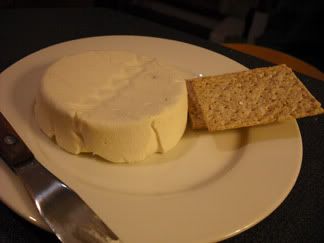I'm inspired. For a while now I have been reading on Natashya, Heather and Simona's blogs about their forays into homemade cheese making. It has all sounded amazing and wonderful and I decided that I really had to have a go at it. I ordered some supplies from Leeners, bought a couple of litres of full-fat goats milk from the supermarket and got stuck in.

 I
Istarted with these recipes, following the method for cheddar because it sounded the most achievable. I didn't have the right sized mould for making a single cheese, so I used egg rings, lined with scalded cheesecloth and set in my bamboo steamer. 2l of milk made 4 cheeses. The curds didn't set up as firmly as I was anticipating, so I abandoned the idea of pressing them into
 a hard cheese, and just went where I was led, into a soft goats cheese.
a hard cheese, and just went where I was led, into a soft goats cheese.After 2 days draining I turned them out of their moulds, onto a fresh piece of scalded cheesecloth, and let them mature for another 4 days before we sampled one. Isn't the pattern from the bamboo steamer pretty? It was delicious. Very mild and creamy, goaty but not intensely so and with an unmistakeable "cheese" texture - it definitely wasn't yoghurt. It had grown up.
The intention was to let the other 3 cheeses mature for longer to see how the flavour developed, but sadly they developed a nasty mould and had to be chucked. Oh well - for a first attempt I was happy!
Of course, when you make cheese at home, you end up with a lot of whey. In a lot of areas (well - Stilton and Parma) a thriving dairy industry has also led to a thriving pork industry, as they whey is fed to the pigs and they grow fat and flavoursome. But I don't have a pig.
The last scoop of the goats curd (which didn't fit into the moulds) and a little of the whey went into my blood orange syrup cakes instead of yoghurt.
 The rest of the whey went to make ricotta. Now, making ricotta this traditional way is very, very low yield. But since it takes no effort and it is really a bonus yield from the cheesemaking, I wasn't too bothered. Remember I started with 2l of milk, got 4 x 10cm cheeses and 200ml of goats curd for my cakes. The 1/2 cup of lovely fresh ricotta was eaten almost straight away,
The rest of the whey went to make ricotta. Now, making ricotta this traditional way is very, very low yield. But since it takes no effort and it is really a bonus yield from the cheesemaking, I wasn't too bothered. Remember I started with 2l of milk, got 4 x 10cm cheeses and 200ml of goats curd for my cakes. The 1/2 cup of lovely fresh ricotta was eaten almost straight away, in this pasta with artichokes dish. It was seriously delicious, but I kept thinking that it'd be even better in summer with fresh baby courgettes substituted for the artichokes.
in this pasta with artichokes dish. It was seriously delicious, but I kept thinking that it'd be even better in summer with fresh baby courgettes substituted for the artichokes.So THEN the whey drained from the ricotta needed a home. Oh yes - I was very keen to make this milk go as far as possible! 1/3 cup went into the syrup for the orange syrup cakes - it added a slight tang and richer flavour than a plain citrus syrup. Some went into the freezer - I hear it makes a good marinade for meat - and some went into a version of this buttermilk syrup (I say "a version" because I used twice the amount of whey as the recipe calls for buttermilk, no corn syrup and no baking soda). Then THAT syrup went into this spelt porridge, which I portioned up and took to work for breakfast.
 Spelt Porridge
Spelt Porridge250g pearled spelt
250ml water
1/4 cup golden flax seed
1/4 cup dessicated coconut
375ml whey syrup
60g dried cranberries
80g dried figs, cut into quarters
100g hazelnuts, roughly chopped
Combine ingredients in a heavy bottomed pan. Bring to the boil, cover and simmer gently on a low heat for about 1/2 hour, stirring frequently, or until it is thick and gelatinous and the spelt is tender. Serve hot, with extra cold milk poured over. It's very filling and sustaining.
A Guest Post by Foodycat.
